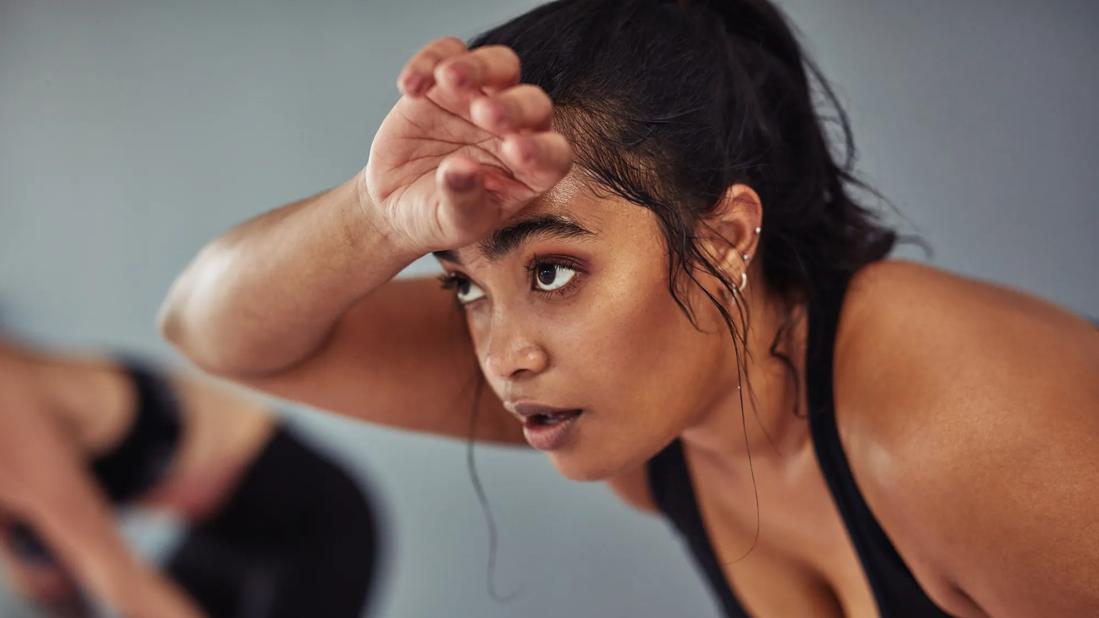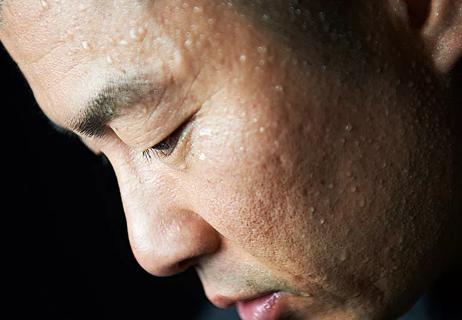Tackle perspiration and odor by wearing breathable fabrics, showering after exercising and using an absorbent powder

Sweat happens almost anywhere on your body: Your hands, feet, face, underarms and even under your breasts.
Advertisement
Cleveland Clinic is a non-profit academic medical center. Advertising on our site helps support our mission. We do not endorse non-Cleveland Clinic products or services. Policy
Sometimes called “underboob sweat” or “boob sweat,” the perspiration under your breasts can cause discomfort and embarrassment, and in some cases, lead to irritation and infection.
Dermatology specialist Lauren Zamborsky, CNP, shares why we tend to sweat under our breasts and how to reduce underboob sweat.
Sweaty boobs can be annoying. So, why does this happen?
“It’s not that you necessarily sweat more in this area. Oftentimes, you notice moisture gets trapped under your breasts because it’s where skin touches skin,” explains Zamborsky. “That area has less airflow to help sweat evaporate so it can collect in those areas.”
And you may think of sweat glands as only being under your arms, but there are two kinds of sweat glands — eccrine and apocrine — located all over your body, including your breasts.
Have you noticed that the sweat under your breasts has a unique smell? Zamborsky says that scent comes from your apocrine glands.
“The official name for sweat that smells bad is bromhidrosis,” she shares. “Your apocrine glands specifically secrete an oily fluid, which oftentimes is odorless. But that characteristic odor develops because of the bacterial decomposition of that oily fluid.”
You may think underboob sweat is nothing to worry about. You take a shower and you’re good to go.
Advertisement
And in most cases, that’s what happens. But for some, you may develop skin irritation and inflammation under your breasts known as intertrigo or folliculitis, an irritation of your hair follicle. Both skin conditions can lead to a bacterial or fungal infection.
“A lot of these things develop because moisture gets trapped, your skin rubs against skin and even the material of your bra can cause excessive friction,” outlines Zamborsky. “Sometimes, just the heat and sweat alone can lead to hives.”
Now that you know why you’re sweating under your boobs, what can you do about it? Zamborsky offers up the following tips to help you prevent sweaty underboobs.
The clothes you wear while working out (or just in your everyday life) can affect how much you sweat. Don’t wear tight shirts or shirts made with synthetic materials such as nylon, acrylic or spandex. Instead opt for loose-fitting, breathable fabrics like cotton that will help wick away moisture from your skin.
Zamborsky adds that choosing light-colored fabrics as well can help reflect the sun. And you may even want to modify your sports bra.
“Even something as simple as eliminating the removable padding that comes in your sports bra can make a huge difference because those can hold onto sweat.”
Don’t overlook the power of rinsing off after a sweat session.
“Ideally, it’s going to be best if you can shower afterward exercising. Wash those areas with soap and water. Even a benzoyl peroxide cleanser can be very helpful,” notes Zamborsky. “Sometimes, just changing your hygiene behaviors can be enough to reduce bacterial colonization that causes odor.”
And if you can’t shower right away, it may be helpful to change into another set of clean clothes to help reduce the chance of infections.
You’re probably used to applying deodorant to only your underarms — but whole-body deodorant has been gaining traction. And this can be used under your boobs to help mask odor and absorb sweat.
There are many options available online or in stores — and Zamborsky says you can use regular deodorant as well. Deodorants come in solids, gels, sprays, creams and even wipes.
Regardless of the kind you use, make sure you read the ingredient lists and opt for products that don’t contain any harsh dyes or fragrances that may irritate your skin.
Talc-free baby powder can be a useful tool to combat sweat. You can apply the powder to your skin before you put on your bra and shirt.
Additionally, there are a variety of absorbent powders available that Zamborsky says can be effective at battling sweat and odor.
Advertisement
“If you’re more prone to fungal infections, there are over-the-counter antifungal powders that your healthcare provider can recommend.”
Do you notice chafing and irritation under your boobs?
“Using a skin barrier balm or cream can reduce friction,” suggests Zamborsky. “You may also want to look at your bra and make sure you’re wearing a supportive bra.”
There are plenty of skin barrier balms and creams for you to choose from. Just like using a powder, you should apply them to clean, dry skin before you put on your bra. (And a bonus? You can also use them on other areas that are prone to chafing and irritation, like your groin.)
Fruits and vegetables with high water content like leafy greens, watermelon and grapes are great for boosting your hydration.
On the flip side, spicy foods, sugary foods, processed foods, caffeine and alcohol can increase your body’s internal temperature, which may make you sweat more.
While it may seem like a minor annoyance, you don’t have to live with underboob sweat. You can take proactive steps to prevent sweating in the first place. But if nothing seems to work or you’re frustrated with how sweaty you are, don’t hesitate to speak to a healthcare provider.
Advertisement
“Make an appointment to see your healthcare provider sooner rather than later. If there’s an underlying, rash or infection, it’s going to require treatment with antifungal creams or powders or topical oral antibiotics,” states Zamborsky.
“Sometimes, the pain you can experience with the associated complications of excessive sweating underneath your breasts are going to require alternative treatments. And those symptoms can be debilitating.”
Advertisement
Learn more about our editorial process.
Advertisement

If you’re waking up drenched, it could be menopause, stress, medications and other causes

Exercise, weather, anxiety, hormone changes and spicy foods can cause you to perspire more than usual

It can be a warning sign of low blood sugar or something more serious like a heart attack

Stay cool by wearing breathable clothes, eating certain foods and using an antiperspirant

One reduces the amount of sweat, while the other masks body odor

The sweaty truth: why sweet smells turn foul

This chronic condition most commonly causes pelvic pain and severe cramping during periods, but it can bring other types of pain symptoms, too

These over-the-counter kits are 99% effective at identifying when you’re most fertile each month

The best parenting style balances enforcing rules and showing plenty of love

Tips include cutting back on sugar, focusing on exercise and managing stress

It can be harder to let go when you’ve invested time, energy and emotions — but it might be the healthier choice long term